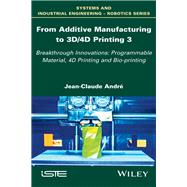With a turnover of some 5-15 billion € / year, the additive manufacturing has industrial niches bearers thanks to processes and materials more and more optimized. While some niches still exist on the application of additive techniques in traditional fields (from jewelery to food for example), several trends emerge, using new concepts: collective production, realization of objects at once (without addition Of material), micro-fluidic, 4D printing exploiting programmable materials and materials, bio-printing, etc. There are both opportunities for new markets, promises not envisaged less than 10 years ago, but difficulties in reaching them.








